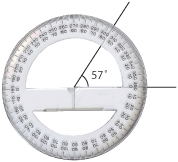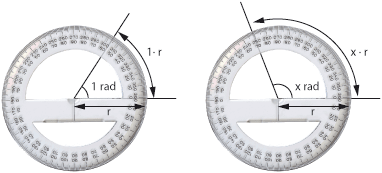4.1 Winkel und Kreise
Aus Online Mathematik Brückenkurs 1
K (Robot: Automated text replacement (-Keep([\s\n]+)in([\s\n]+)mind([\s\n]+)that: +Bedenke folgendes:)) |
K (Robot: Automated text replacement (-Useful([\s\n]+)web([\s\n]+)sites +Nützliche Websites)) |
||
| Zeile 350: | Zeile 350: | ||
| - | ''' | + | '''Nützliche Websites''' |
[http://www.math.kth.se/online/images/sinus_och_cosinus_i_enhetscirkeln.swf Interactive experiments: the sine and cosine on the unit circle ] (Flash) | [http://www.math.kth.se/online/images/sinus_och_cosinus_i_enhetscirkeln.swf Interactive experiments: the sine and cosine on the unit circle ] (Flash) | ||
</div> | </div> | ||
Version vom 08:11, 28. Okt. 2008
| Theorie | Übungen |
Inhalt:
- Various angle measures (degrees, radians and revolutions)
- The Pythagorean theorem
- Formula for distance in the plane
- Equation of a circle
Lernziele:
Nach diesem Abschnitt sollst Du folgendes können :
- To convert between degrees, radians and revolutions.
- To calculate the area and circumference of sectors of a circle.
- The concepts of right-angled triangles including its legs and hypotenuse.
- To formulate and use the Pythagorean theorem.
- To calculate the distance between two points in the plane.
- To sketch circles by completing the square in their equations.
- The concepts of unit circle, tangent, radius, diameter, circumference, chord and arc.
- To solve geometric problems that contain circles.
Angle measures
There are several different units for measuring angles, which are used in different contexts. The two most common within mathematics are degrees and radians.
- Degrees. If a complete revolution is divided into 360 parts, then each part is called 1 degree. Degrees are designated by \displaystyle {}^\circ.
- Radians. Another way to measure an angle, is to use the length of the arc which subtends the angle in relation to the radius as a measure of the angle. This unit is called radian. A revolution is \displaystyle 2\pi radians as the circumference of a circle is \displaystyle 2\pi r, where \displaystyle r is the radius of the circle.
A complete revolution is \displaystyle 360^\circ or \displaystyle 2\pi radians which means
\displaystyle \begin{align*}
&1^\circ = \frac{1}{360} \cdot 2\pi\ \mbox{ radians }
= \frac{\pi}{180}\ \mbox{ radians,}\\
&1\ \mbox{ radian } = \frac{1}{2\pi} \cdot 360^\circ
= \frac{180^\circ}{\pi}\,\mbox{.}
\end{align*}
|
These conversion relations can be used to convert between degrees and radians.
Beispiel 1
- \displaystyle 30^\circ = 30 \cdot 1^\circ = 30 \cdot \frac{\pi}{180}\ \mbox{ radians } = \frac{\pi}{6}\ \mbox{ radians }
- \displaystyle \frac{\pi}{8}\ \mbox { radians } = \frac{\pi}{8} \cdot (1 \; \mbox{radians}\,) = \frac{\pi}{8} \cdot \frac{180^\circ}{\pi} = 22{,}5^\circ
In some contexts, it may be useful to talk about negative angles and angles greater than 360°. This means that the same direction can be designated by different angles that differ from each other by an integral number of revolutions.
![[Image]](/wikis/2009/bridgecourse1-TU-Berlin/img_auth.php/metapost/a/d/b/adb5d2a7377ac4e092456d9ca65e66a3.png)
Beispiel 2
- The angles \displaystyle -55^\circ and \displaystyle 665^\circ
indicate the same direction because
\displaystyle -55^\circ + 2 \cdot 360^\circ = 665^\circ\,\mbox{.} - The angles \displaystyle \frac{3\pi}{7} and \displaystyle
-\frac{11\pi}{7} indicate the same direction because
\displaystyle \frac{3\pi}{7} - 2\pi = -\frac{11\pi}{7}\,\mbox{.} - The angles \displaystyle 36^\circ and \displaystyle
216^\circ do not specify the same direction, but opposite directions since
\displaystyle 36^\circ + 180^\circ = 216^\circ\,\mbox{.}
Formula for distance in the plane
The theorem of Pythagoras is one of the most famous theorems in mathematics and says that in a right-angled triangle with the legs \displaystyle a and \displaystyle b, and the hypotenuse \displaystyle c then
The Pythagorean theorem:
|
|
Beispiel 3
The triangle on the right is
and therefore hypotenuse \displaystyle c is equal to
|
|
The Pythagorean theorem can be used to calculate the distance between two points in a coordinate system.
Formula for distance:
The distance \displaystyle d between two points with coordinates \displaystyle (x,y) and \displaystyle (a,b) is
| \displaystyle d = \sqrt{(x – a)^2 + (y – b)^2}\,\mbox{.} |
The line joining the points is the hypotenuse of a triangle whose legs are parallel to the coordinate axes.
![[Image]](/wikis/2009/bridgecourse1-TU-Berlin/img_auth.php/metapost/b/2/6/b26ce49791aa401bb74412d49e5ba4f4.png)
The legs of the triangle have lengths equal to the difference in the x- and y-directions of the points, that is \displaystyle |x-a| and \displaystyle |y-b|. The Pythagorean theorem then gives the formula for the distance.
Beispiel 4
- The distance between \displaystyle (1,2) and \displaystyle (3,1) is
\displaystyle d = \sqrt{ (1-3)^2 + (2-1)^2} = \sqrt{(-2)^2 + 1^2} = \sqrt{ 4+1} = \sqrt{5}\,\mbox{.} - The distance between \displaystyle (-1,0) and \displaystyle (-2,-5) is
\displaystyle d = \sqrt{ (-1-(-2))^2 + (0-(-5))^2} = \sqrt{1^2 + 5^2} = \sqrt{1+25} = \sqrt{26}\,\mbox{.}
Circles
A circle consists of all the points that are at a given fixed distance \displaystyle r from a point \displaystyle (a,b).
![[Image]](/wikis/2009/bridgecourse1-TU-Berlin/img_auth.php/metapost/0/6/2/06282cc22b3fe6eeea36613925ce586b.png)
The distance \displaystyle r is called the circle´s radius and the point \displaystyle (a,b) is its centre. The figure below shows the other important concepts.
|
|
|
|
| |||
| Diameter | Tangent | Chord | Secant | |||
|
|
|
|
| |||
| Arc of a circle | circumference | sector of a circle | segment of a circle |
Beispiel 5
A sector of a circle is given in the figure on the right.
|
|
- The way radians have been defined means that the arc length is the radius multiplied by the angle measured in radians,
\displaystyle 3 \cdot \frac{5\pi}{18}\ \mbox{units } = \frac{5\pi}{6}\ \mbox{ units . }
- Determine the area of the circle segment.
The circle segment´s share of the entire circle is\displaystyle \frac{50^\circ}{360^\circ} = \frac{5}{36}and this means that its area is \displaystyle \frac{5}{36} parts of the circle area, which is \displaystyle \pi r^2 = \pi 3^2 = 9\pi, i.e.
\displaystyle \frac{5}{36} \cdot 9\pi\ \mbox{ units }= \frac{5\pi}{4}\ \mbox{ units. }
A point \displaystyle (x,y) lies on the circle that has its centre at \displaystyle (a,b) and radius \displaystyle r, if its distance from the centre is equal to \displaystyle r. This condition can be formulated with the distance formula as
Circle equation:
|
|
Beispiel 6
|
|
|
|
|
|
Beispiel 7
- Does the point \displaystyle (1,2) lie on the circle \displaystyle (x-4)^2 +y^2=13?
Inserting the coordinates of the point \displaystyle x=1 and \displaystyle y=2 in the circle equation, we have that\displaystyle \begin{align*} \mbox{LHS } &= (1-4)^2+2^2\\ &= (-3)^2+2^2 = 9+4 = 13 = \mbox{RHS}\,\mbox{.} \end{align*}Since the point satisfies the circle equation it lies on the circle.
![[Image]](/wikis/2009/bridgecourse1-TU-Berlin/img_auth.php/metapost/c/2/b/c2b604362bebb4cb5d5959a822a50d9b.png)
- Determine the equation for the circle that has its centre at \displaystyle (3,4) and goes through the point \displaystyle (1,0).
Since the point \displaystyle (1,0) lies on the circle, the radius of the circle must be equal to the distance of the point from \displaystyle (1,0) to the centre \displaystyle (3,4). The distance formula gives that this distance is\displaystyle c = \sqrt{(3-1)^2 + (4-0)^2} = \sqrt{4 +16} = \sqrt{20} \, \mbox{.}The circle equation is therefore
\displaystyle (x-3)^2 + (y-4)^2 = 20 \; \mbox{.} ![[Image]](/wikis/2009/bridgecourse1-TU-Berlin/img_auth.php/metapost/2/e/7/2e78c8b92478416492f4a0953246469b.png)
Beispiel 8
Determine the centre and radius of the circle with equation \displaystyle \ x^2 + y^2 – 2x + 4y + 1 = 0.
Let us try to write the equation of the circle in the form
| \displaystyle (x – a)^2 + (y – b)^2 = r^2 |
because then we can directly read from this that the midpoint is \displaystyle (a,b) and the radius is \displaystyle r.
Start by completing the square for the terms containing \displaystyle x on the left-hand side
\displaystyle
\underline{x^2-2x\vphantom{(}} + y^2+4y + 1
= \underline{(x-1)^2-1^2} + y^2+4y + 1
|
(the underlined terms shows the terms involved).
Complete the square for the terms containing \displaystyle y
\displaystyle
(x-1)^2-1^2 + \underline{y^2+4y} + 1
= (x-1)^2-1^2 + \underline{(y+2)^2-2^2} + 1\,\mbox{.}
|
The left-hand side is equal to
| \displaystyle (x-1)^2 + (y+2)^2-4 |
and moving over the 4 to to the right-hand side we get the equation
| \displaystyle (x-1)^2 + (y+2)^2 = 4 \, \mbox{.} |
We can interpret this as follows: The centre is at \displaystyle (1,-2) and the radius is \displaystyle \sqrt{4}= 2.
![[Image]](/wikis/2009/bridgecourse1-TU-Berlin/img_auth.php/metapost/7/b/2/7b2d3a06ca4d11646449b1541cdab526.png)
Tipps fürs lernen
Diagnostische Prüfung und Schlussprüfung
Nachdem Du fertig mit der Theorie bist, sollst Du die diagnostische Prüfung und die Schlussprüfung machen. Du findest die links zu den Prüfungen in Deiner "Student Lounge".
Bedenke folgendes:
Reviews
For those of you who want to deepen your studies or need more detailed explanations consider the following references:
Learn more about Pythagoras theorem in English Wikipedia
Read more in Mathworld about the circle
Nützliche Websites
Interactive experiments: the sine and cosine on the unit circle (Flash)


![[Image]](/wikis/2009/bridgecourse1-TU-Berlin/img_auth.php/metapost/7/2/9/7297c9bc30e68c93394025b132182670.png)
![[Image]](/wikis/2009/bridgecourse1-TU-Berlin/img_auth.php/metapost/d/2/f/d2ff7df26ceb7ecc6fab9646b919d9dd.png)
![[Image]](/wikis/2009/bridgecourse1-TU-Berlin/img_auth.php/metapost/8/2/1/821b8a352c39f6b69318c96ec25a84e7.png)
![[Image]](/wikis/2009/bridgecourse1-TU-Berlin/img_auth.php/metapost/2/3/e/23e1cbb7c8b731963ffa4aeda821b277.png)
![[Image]](/wikis/2009/bridgecourse1-TU-Berlin/img_auth.php/metapost/a/2/7/a27e381d480493ba0cb77e460cd17758.png)
![[Image]](/wikis/2009/bridgecourse1-TU-Berlin/img_auth.php/metapost/4/a/5/4a54d959f82763e83e41a86ad60933d2.png)
![[Image]](/wikis/2009/bridgecourse1-TU-Berlin/img_auth.php/metapost/b/2/0/b20d39083d55d8fe6e7454c1815f021b.png)
![[Image]](/wikis/2009/bridgecourse1-TU-Berlin/img_auth.php/metapost/f/a/4/fa48ec8305ef998ba790a540ab326c6f.png)
![[Image]](/wikis/2009/bridgecourse1-TU-Berlin/img_auth.php/metapost/5/c/9/5c9f453cdf00df1693557161cc6fceb4.png)
![[Image]](/wikis/2009/bridgecourse1-TU-Berlin/img_auth.php/metapost/a/f/d/afd624e400bff836280c119ab4cb970a.png)
![[Image]](/wikis/2009/bridgecourse1-TU-Berlin/img_auth.php/metapost/4/7/e/47e696fd84f13fed85b1394795a31875.png)
![[Image]](/wikis/2009/bridgecourse1-TU-Berlin/img_auth.php/metapost/c/1/b/c1b9fe94e84310b947c2f12983ec753d.png)
![[Image]](/wikis/2009/bridgecourse1-TU-Berlin/img_auth.php/metapost/1/a/4/1a4fb90a0e677a995867186eb909f5b5.png)
![[Image]](/wikis/2009/bridgecourse1-TU-Berlin/img_auth.php/metapost/b/2/1/b2185b3d2e88d185bc40539702f21363.png)
![[Image]](/wikis/2009/bridgecourse1-TU-Berlin/img_auth.php/metapost/4/d/e/4de1b674a9d9f670007e817471136f91.png)
